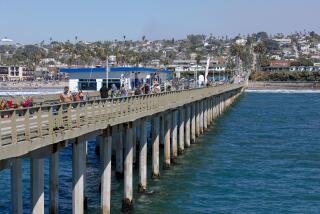Historic bridge to be razed
A modern cable-supported bridge will replace the stately concrete piers and graceful steel arches of the 6th Street Bridge over the Los Angeles River, the City Council decided Friday, when it voted to demolish the beloved, but fatally decaying 79-year-old span.
The chance to build a new monument that reflects contemporary design won out over an appeal from preservationists to replicate at least the signature double arches. The bridge is one of a dozen historic river bridges built in grand style by an ascendant city in the early part of the last century.
“We’re going to have a bridge that links to the city’s past while looking to the future,” Councilman Jose Huizar said as he lamented the loss of the majestic bridge that links downtown and Boyle Heights.
Tom LaBonge was the only council member to vote against the modern design. “This drastically changes what is a tremendous view of this bridge,” he said. “It hurts me to see that we would let this bridge go.”
The Cultural Heritage Commission and the Los Angeles Conservancy pressed the council to adopt a conceptual approach that would have replicated the arches for an extra $20 million, saying the 6th Street Viaduct was designed to complement the unique ensemble of Los Angeles River bridges.
But Gary Lee Moore, the city engineer, urged the council to go with the most up-to-date technology and style, saying that was the consensus that emerged in public meetings after people learned that a carbon-copy reproduction was not feasible. “We’ve had a tremendous amount of community outreach,” he said, “The community said we wanted something new and different.”
Council members worried about whether the federal government, which will pay for most of the $401-million project, will come through and passed a resolution calling on the city to advocate for a transportation bill that includes the money to complete the bridge replacement.
Construction could begin in about three years and take four years, during which time the bridge would be closed. The route will be shifted to the north, which will could affect up to 33 businesses and cause about 200 employees to lose their jobs at least temporarily. Huizar and city officials said they were still working to minimize the potential effects. The demolition of the longest city-owned bridge and construction of the new one will also cause traffic delays and air pollution.
The council’s decision allows the city to move forward with the design. The process will include extensive public outreach, including an aesthetic advisory committee that will weigh in on such features as colors, accent lighting, railings and monumental gateways at the entrances.
Richard Barron, an architect and president of the Cultural Heritage Commission, said the commissioners will turn to influencing the design. He said the commission would try to ensure that the new bridge incorporates references to the old bridge’s admired Art Deco and Streamline Moderne features in an appropriate manner. “I think what we want to avoid is a Christmas decoration approach,” he said.
Alex Ward, an architect who is chairman of Friends of the Los Angeles River, advocated the contemporary design, saying it was “the best springboard to a world-class new bridge.” He said the proposed partial reproduction was “an unsatisfactory attempt at reproduction of the existing bridge, which is neither accurate nor has the grace and poetry of the original.”
The new bridge will have wider sidewalks and room for bicycles. It will have no piers on the embankment, which could eventually allow for a path along the river where railroad tracks now run.
The city also agreed to take steps to try to memorialize the condemned bridge, promising to make a broadcast-quality documentary and publish a booklet with black and white photos on the Los Angeles River bridges, and erect informational plaques about the old bridge at either end of the new structure.
The 6th Street Bridge has an unusual and unstoppable condition called alkali silica reaction, which produces a gel that expands and cracks the concrete. City engineers concluded that the bridge had to come down and preservationists reluctantly agreed. It has a 70% chance of failing in a 7.0 magnitude earthquake, a finding that troubled Councilman Paul Koretz.
“How dangerous is it? Is this a big mistake for us to keep it open? Should we be shutting it down next week?” he asked.
Moore promised to provide the council with more detailed information on the bridge’s safety and said he would ask Caltrans to examine the bridge more frequently than every other year. Caltrans inspected the bridge about 13 months ago. The 11-page report documents extensive cracking and notes that the bridge’s signature arches are rusted and the paint is faded, peeling and dirty.
“There are some problems,” said Maria Raptis, a spokeswoman, “but it is safe.”
--
More to Read
Sign up for Essential California
The most important California stories and recommendations in your inbox every morning.
You may occasionally receive promotional content from the Los Angeles Times.










